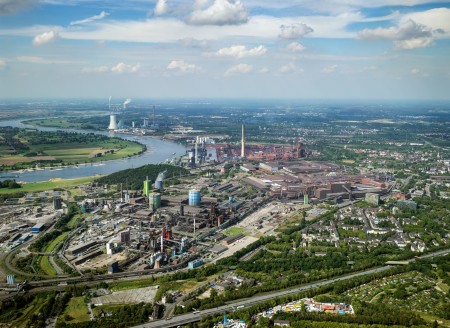Daily press, 2021-03-17, 07:15 am
An innovative idea – great effect for decarbonization: RWTH University scientists’ study confirms thyssenkrupp Steel‘s concept for climate neutrality of integrated steel mills
- Concept technologically feasible, scalable and innovative
- Melting unit allows for downstream value chain and established processes associated with it to remain in place
- All existing steel grades can be produced in the usual quality
Commissioned by thyssenkrupp Steel, the team of Prof. Bernd Friedrich, Director of the renowned Institut IME Metallurgische Prozesstechnik und Metallrecycling of RWTH Aachen University (IME) has analyzed the technical concept of Germany's largest steel producer to integrate the direct reduction process into the existing steel mill with a novel melting unit. The study is focused on validating the furnace technology (“melting unit”) as an intelligent approach to prepare the direct reduced iron for further processing in the existing steel mill. The scientists have come to the clear conclusion that the concept pursued by the Duisburg-based steel producer is technologically feasible, scalable and innovative.
Study confirms feasibility and provides findings for designing the unit
On the basis of thermochemical simulations developed especially for the study, the scientists confirm thyssenkrupp’s main assumptions: The planned melting unit is suitable to melt down the iron reduced in the direct reduction plant, thus producing a liquid hot metal-like material to be processed in the steel mill. The study examined various technical factors such as energy requirements, positioning of electrodes, dimensions of the “melting unit” and the principal usability of slags. Aside from the technical feasibility, the study also provided findings that will now be used for designing the new unit.
Prof. Dr. Bernd Friedrich, Director of IME Metallurgische Prozesstechnik und Metallrecycling at RWTH Aachen University: “The decarbonization of the steel industry is a one-in-a-hundred-years task. thyssenkrupp Steel has developed an innovative and technically feasible solution to avoid CO2 emissions in the steelmaking process by using hydrogen and green power. The projected “melting unit” is an intelligent solution which can be used worldwide to decarbonize integrated steel mills via the direct reduction route. The existing steel mills can thus be maintained and operated on an ongoing basis. This means that in future all existing steel grades can be produced in the usual quality, but largely in a CO2-neutral way“.
Melting unit enables minimal disruption and maximum range of grades
To thyssenkrupp Steel, the factor “steel mill” is essential on its way to climate transformation. As part of the corporate strategy, the company focuses on high-quality premium grades and hence also on the established processes in the two BOF meltshops at the Duisburg site. Early in 2021, the company approved investments in the high three-digit million range to strengthen the capacities in these product segments and important markets of the future like e-mobility.
This study now provides thyssenkrupp Steel with external confirmation of the model for integrating the direct reduction process into the existing metallurgical network in Duisburg. This means that the steel mill can be decarbonized with the lowest possible cost and effort, and, in the long term, the entire portfolio of grades can be produced climate neutrally, including all premium grades. The climate strategy thus fits seamlessly into the company's product strategy, which is focused on premium grades.
Dr. Arnd Köfler, CTO of thyssenkrupp Steel: “Technologically, we are ready to go. We can make our Duisburg steel site climate-neutral by changing the production chains very specifically and only where CO2 emissions arise: by replacing the blast furnaces. The downstream value chain and the established processes associated with it remain in place. That's what makes the concept so attractive: we replace the coal, but we don't replace the steel mill and all downstream units."
Bernhard Osburg, CEO of thyssenkrupp Steel: “The study confirms a key element of our transformation path. There is already a demand for green steel, and we have the technologically innovative and capable concept to meet it. This has now been confirmed by independent third parties. Above all, we will be able to offer our customers our entire product range in the “green“ version, without compromising quality. We now have to dispel existing uncertainties in the framework conditions, especially with regard to funding and the regulatory framework. First of all, we need planning security to establish a robust and competitive business model for green steel. We are determined to play our part in shaping this market and to prove that climate-neutral industry works“.
Further auditor study confirms viability and feasibility of the overall concept of thyssenkrupp Steel
Apart from Prof. Bernd Friedrich’s team, a renowned auditing firm commissioned by the company to analyze the market for green steel, has confirmed that thyssenkrupp’s transformation path is suitable for achieving the company’s climate goals. According to this analysis, there will be a significant market for green steel in Europe by 2030. Moreover, the auditors’ findings confirm that the construction of two DR plants with melting units will make the company’s medium-term climate goal achievable and realistic: The adapted plant configuration will enable thyssenkrupp Steel to reduce its CO2 emissions by 30 percent by 2030.




